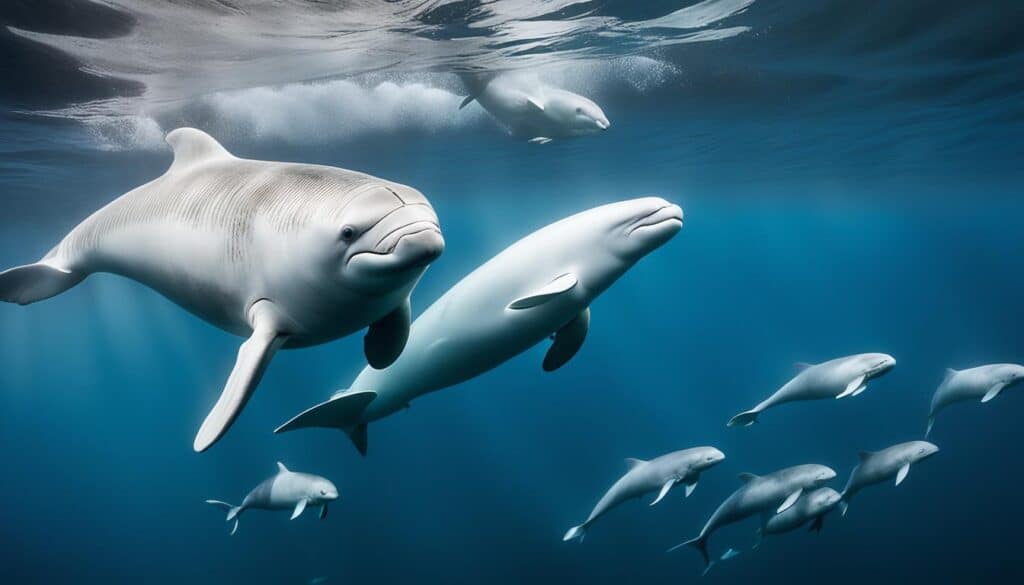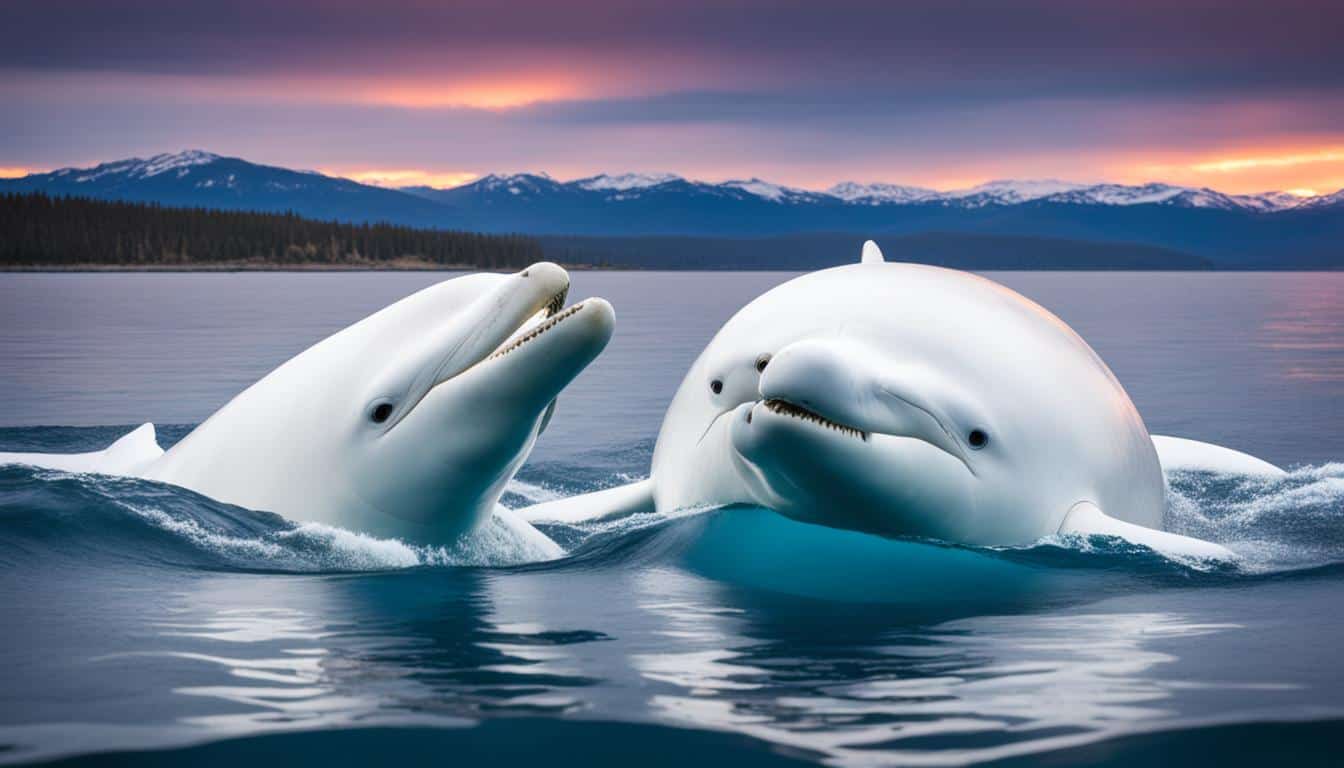Beluga whales, also known as “sea canaries,” have a unique way of reproducing. They have a low birth rate, about once every two to three years. This affects their numbers a lot. They breed in the spring, from March to May, when conditions are best for them.
This timing is important for their survival. They carry their babies for about ten months. Knowing how they reproduce is key, especially since some groups, like the Cook Inlet belugas, are endangered. They face many threats.
Overview of Beluga Whale Reproduction
Beluga whales have fascinating ways of reproducing that help them survive. Learning about the beluga whale breeding cycle shows us how they mate and face challenges in the wild. Males become ready to mate between 8 to 9 years old. Females are ready a bit earlier, between 4 to 7 years old. This difference changes how they reproduce.
During mating, beluga whales become very social. One dominant male may mate with many females in a season. This helps keep the population’s genes diverse. Females have one calf after a long pregnancy, which is key for the calf’s survival.
Calves are born in shallow water, making it easier for their mothers to care for them. The conditions during this time are crucial. They make sure the calves get the care they need from their mothers. The way beluga whale reproductive behavior works shows their special adaptations. It also shows how they need a delicate balance to keep living in a changing world.
| Factor | Male | Female |
|---|---|---|
| Age of Sexual Maturity | 8-9 years | 4-7 years |
| Typical Number of Calves | 0 | 1 |
| Mating Behavior | May mate with multiple females | May mate with multiple males |
Beluga Whale Mating Habits
Beluga whales have fascinating mating habits that happen in small bays and estuaries during breeding season. These places are safe, letting whales interact without being disturbed. They use sounds and social behaviors to communicate during courtship.
It’s important to know about the beluga whale’s reproductive system to understand their mating. In these groups, dominant males fight for a chance to mate with females. This competition helps keep the group in order and ensures the strongest genes for the next generation.
- Breeding occurs in secluded areas during peak seasons.
- Vocalizations are used to attract potential mates.
- Social displays highlight individual strength and dominance.
- Stable pod structures foster complex social interactions.
How do beluga whales reproduce?
Beluga whales reproduce in a complex way. They have specific seasons for breeding and live in social groups. These groups affect their mating habits. Environmental conditions and social rank also play big roles.
Understanding Reproductive Seasons
The breeding season for beluga whales is from March to May. This is the best time for their babies to survive. Female belugas, ready from previous years, look for mates during this time.
They choose mates based on the environment. This ensures the best chance for their young to thrive.
The Role of Dominant Males
Beluga whales live in groups with a social order. Dominant males are key in mating. They compete to show they are the strongest and fittest.
They use both physical and sound signals to attract females. These sounds help them show off and find mates. This shows how complex their mating is.
Beluga Whale Breeding Cycle
The breeding cycle of beluga whales is closely tied to their reproductive system. Knowing when they breed is key to their survival. Let’s look at how breeding affects their survival and the health of their young.
Timing of Breeding Activities
Beluga whales have a long pregnancy that lasts about 14 months. This long time is a challenge for both mothers and their babies. Babies are born in late spring or early summer, when the water is warmer, helping the calves to survive.
Female belugas have a baby every 2 to 3 years. This means they don’t have many babies, making their reproduction slow. This slow rate is affected by things like climate change and losing their homes. By knowing this, we can see how fragile their reproductive system is.
Beluga Whale Pregnancy Duration
The gestation of beluga whales is unique, showing how they adapt to cold waters. Knowing how long they are pregnant helps us understand their reproductive cycle. It also shows how it helps in the growth of healthy calves.
Gestation Period Details
Beluga whales are pregnant for about 14 months. This long pregnancy helps their calves grow well in icy waters. When they are born, calves are about 5 feet long and weigh 90 to 130 pounds. This shows how much they grow before birth.
When it’s time to give birth, pregnant females go to shallow waters. This helps the newborn find its way to the surface for its first breath. This behavior is crucial for the calf’s safety from predators. It highlights the importance of the long pregnancy in helping the calf survive and stay healthy.
Calf Development and Maternal Care
Maternal care is key to the growth and survival of beluga whale offspring. The bond between a mother and her calf is vital. This bond helps the calf grow and thrive. Nursing lasts up to two years, providing both nutrition and emotional support.
Nursing Practices
Nursing is crucial for beluga calves in the early stages of life. Mothers give milk rich in nutrients to support growth. Nursing includes:
- Duration: Calves nurse for up to 24 months.
- Frequency: They nurse several times a day.
- Bonding: Close contact helps mother and calf bond.
Calf Independence Timeline
As beluga calves grow, they start to explore and still depend on their mothers. When they become independent varies by individual. Most calves start venturing out on their own at two years old. This marks a big change for both the calf and mother in their development. Here is a timeline:
| Age (Months) | Development Stage | Nursing Status |
|---|---|---|
| 0-6 | Neonate | Exclusively nursing |
| 7-12 | Infant | Nursing with exploration |
| 13-24 | Juvenile | Reduced nursing, increased independence |

Beluga Whale Reproductive Behavior
The way beluga whales reproduce is complex and interesting. In their groups, social rules are key. Males compete to be the top dog to get a chance to mate. This helps us understand how they find mates during mating season.
Beluga whales also use sounds to talk to each other. They make many different noises to help with mating and taking care of their young. These sounds are important for partners to connect and for mothers to teach their babies.
As their homes in the water change, it’s more important to know about beluga whales’ behavior. Their social and sound behaviors help them survive. Learning about this shows us why we need to protect their homes.
FAQ
How do beluga whales reproduce?
Beluga whales have a special way of reproducing. They do this every two to three years, from March to May. This is because of their environment.
What is the gestation duration for beluga whales?
Beluga whales are pregnant for about 14 months. This lets their babies grow well in cold water.
At what age do beluga whales become sexually mature?
Male beluga whales grow up and can have babies at 8 to 9 years old. Female beluga whales are ready at 4 to 7 years old.
What are the mating habits of beluga whales?
Beluga whales have complex ways of mating. Dominant males mate with many females. They also make sounds during the mating season.
How does the reproductive behavior of beluga whales influence their population?
Knowing how beluga whales reproduce helps us protect them. Their low birth rate and the impact of the environment affect their numbers.
How do environmental conditions affect beluga whale breeding?
Beluga whales breed when the environment helps their babies survive best. This usually happens in the spring.
What role do dominant males play in beluga whale reproduction?
Dominant males show off to attract females. This affects how they mate and who leads in the group.
How long do calves rely on their mothers after birth?
Calves stay with their mothers for up to two years. They learn important survival skills and form strong bonds during this time.
What are the initial sizes of beluga whale calves at birth?
Newborn beluga whale calves are about 5 feet long and weigh 90 to 130 pounds.
How does maternal care affect beluga whale calf development?
The care from mothers is crucial for the growth of calves. It ensures they get enough food and safety, especially when they are young.







